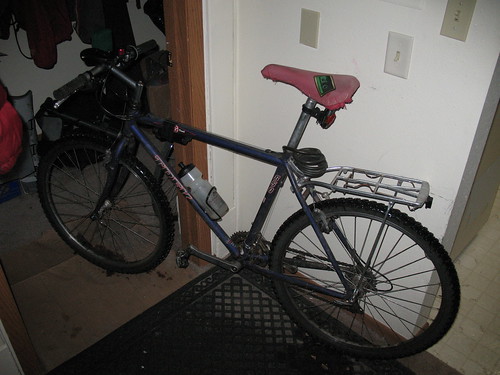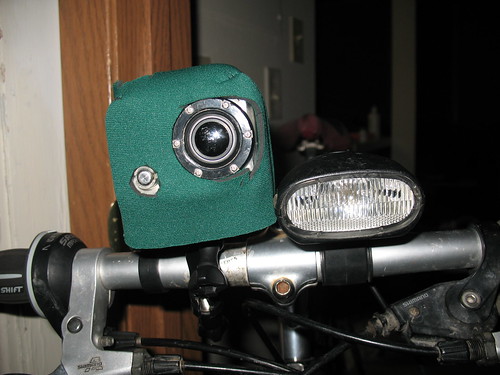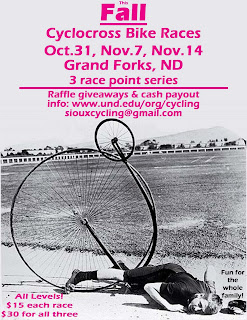[EDIT: My winter riding setup has changed quite a bit since this post. The basics are there, but I’ve upgraded pretty much all of my clothing, requiring me to wear fewer, lighter layers. I’ve replaced the bicycle (won a Pugsley frame at a race), upgraded the lighting, and gone to flat pedals with Power Grips combined with Muck boots for my feet. 2014-02-05]
I just got back a while ago (:-P) from my first “official” training ride of the winter season. It snowed the weekend before Thanksgiving, but I was returning from the Smithsonian and missed out on the freshie powder, then was busy all week aside from commuting. This evening I finished what I was doing in time to get some real training in.
 |
|
(All You Haters Stud My Tires) |
The temperature when I returned (a little before 7 PM) was 17 F (-8 C), so it’s balmy by Grand Forks standards (or it will be by March!). There was an 11 MPH (17 km/hr) breeze from the north, but it definitely (to my out-of-shape body) felt like a lot more than that. I did the pedestrian bridge loop (to north bridge to south bridge and back) on my mountain bike, following the Greenway path. The path is nicely plowed for the most part, so much so that once my light died I could still see well enough to not endo over any piles of snow kicked up by the snowmobiles (the clear sky may have helped in this regard; nothing like following a black ribbon through a white wilderness).
As I said, the wind being from the north I got a bit of a workout, followed by a long period of speed, followed by my realization that I had forgotten how much of a workout I’d had at first, once I got to turn back into the wind. The weather was nice, and I think I dressed appropriately, which is always something of a challenge for me. I tend to run hot, which up until recently has resulted in me winding up drenched by the time I get to school since I wear a down jacket. I finally bought a clip-on pannier/shopping bag that I can throw my messenger bag into and not have to carry it on my back, so it’s much easier to regulate my temperature while commuting.
Anyway, back to tonight: the image below shows what I was wearing, with a list in case people are interested. I was warm enough with the tailwind, but the headwind sections were somewhat chilly on the knees and arms. I tried out vapor barriers for my feet for the first time since I have chronically cold toes in the winter; they may have worked, or it may have been too warm for me to feel the difference. Any time I can step off the bike and not feel like I’m standing on two frozen lumps of flesh is a good day.
 |
|
(All You Haters Wash My Shorts) |
“RED” snowboarding helmet (from Play It Again Sports)
(from Play It Again Sports)
Smith goggles  and neckwarmer (from Ali!)
and neckwarmer (from Ali!)
bike shorts from inside baggy mtb shorts
Teko socks from END-AR 2009
from END-AR 2009
plastic bags from phonebooks
cheap Nike mtb shoes
wool mittens (knitted by Mum) inside Swedish mitts from Midwest Mountaineering
North Face fleece (from Ali’s parents)
(from Ali’s parents)
Cloudveil pants (from Ali)
pants (from Ali)
Under Armour coldgear shirt (from a guy I ran with at SLU)
coldgear shirt (from a guy I ran with at SLU)
My other equipment could use an upgrade (maybe someone could b[u]y me this?), especially my front lighting system. I bought this light when I first got my mountain bike in eighth grade (thankfully the frame has proven large enough!). It runs a single incandescent bulb, I have no idea what the candlepower is, and uses 4 D batteries. It also seems to be having a lot of trouble in the cold this year 🙁
 |
|
(All You Haters Velcro My Batteries) |
Since I’m trying to limit the whole blog post production time (BPPT) to a half-hour or less, I’ll only throw up one more photo of my new camera sweater. I’m not sure it works to keep things warm so the batteries last longer, but my buddy Mario (now Cat 2 road, congrats!) uses a similar setup for his power meter, and considering he’s an electrical engineer, it can’t have deleterious effects. I’ve been taking some decent winter commuting videos, so hopefully they’ll make it up eventually.
 |
|
(All You Haters Sweater My Camera) |
Happy riding!
Ride distance: 16.2 km
Ride time: 45:11
Average speed: 21 km/hr








